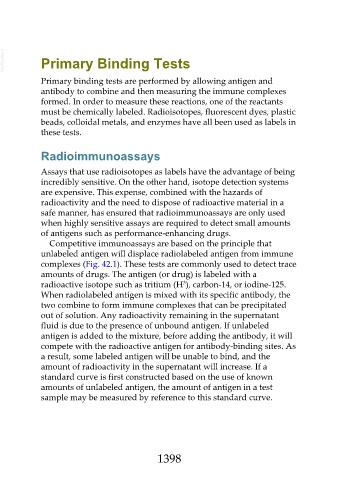Page 1398 - Veterinary Immunology, 10th Edition
P. 1398
VetBooks.ir Primary Binding Tests
Primary binding tests are performed by allowing antigen and
antibody to combine and then measuring the immune complexes
formed. In order to measure these reactions, one of the reactants
must be chemically labeled. Radioisotopes, fluorescent dyes, plastic
beads, colloidal metals, and enzymes have all been used as labels in
these tests.
Radioimmunoassays
Assays that use radioisotopes as labels have the advantage of being
incredibly sensitive. On the other hand, isotope detection systems
are expensive. This expense, combined with the hazards of
radioactivity and the need to dispose of radioactive material in a
safe manner, has ensured that radioimmunoassays are only used
when highly sensitive assays are required to detect small amounts
of antigens such as performance-enhancing drugs.
Competitive immunoassays are based on the principle that
unlabeled antigen will displace radiolabeled antigen from immune
complexes (Fig. 42.1). These tests are commonly used to detect trace
amounts of drugs. The antigen (or drug) is labeled with a
3
radioactive isotope such as tritium (H ), carbon-14, or iodine-125.
When radiolabeled antigen is mixed with its specific antibody, the
two combine to form immune complexes that can be precipitated
out of solution. Any radioactivity remaining in the supernatant
fluid is due to the presence of unbound antigen. If unlabeled
antigen is added to the mixture, before adding the antibody, it will
compete with the radioactive antigen for antibody-binding sites. As
a result, some labeled antigen will be unable to bind, and the
amount of radioactivity in the supernatant will increase. If a
standard curve is first constructed based on the use of known
amounts of unlabeled antigen, the amount of antigen in a test
sample may be measured by reference to this standard curve.
1398

